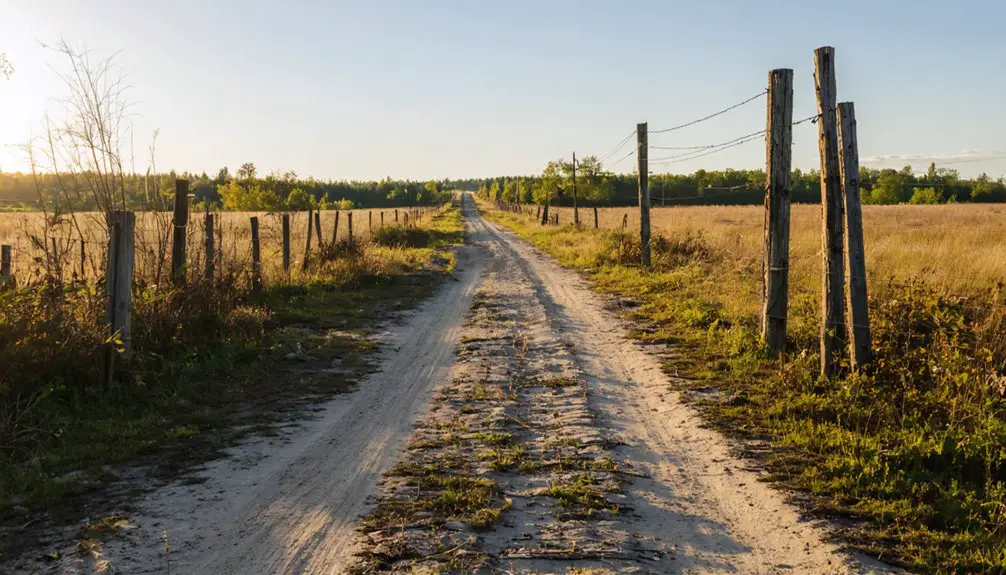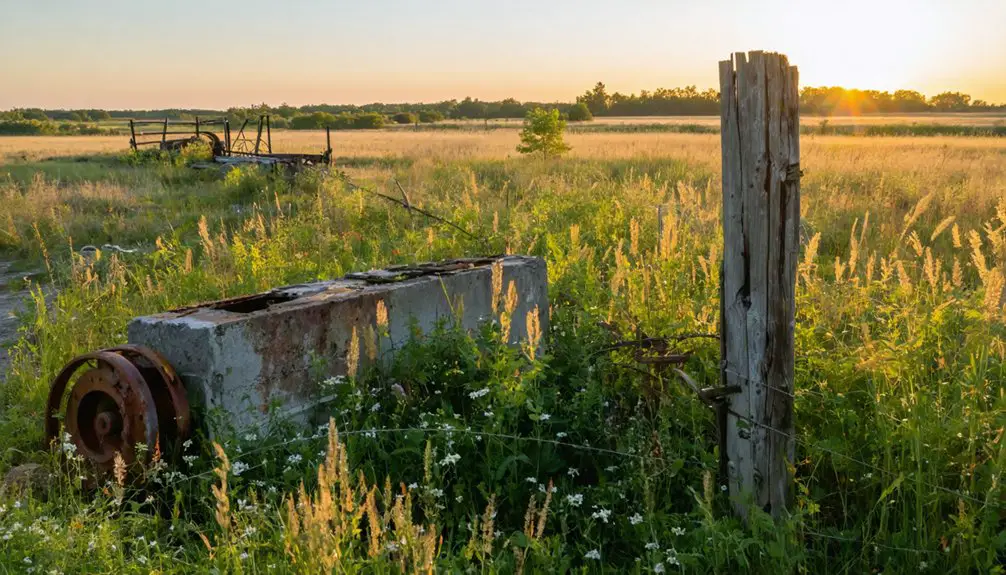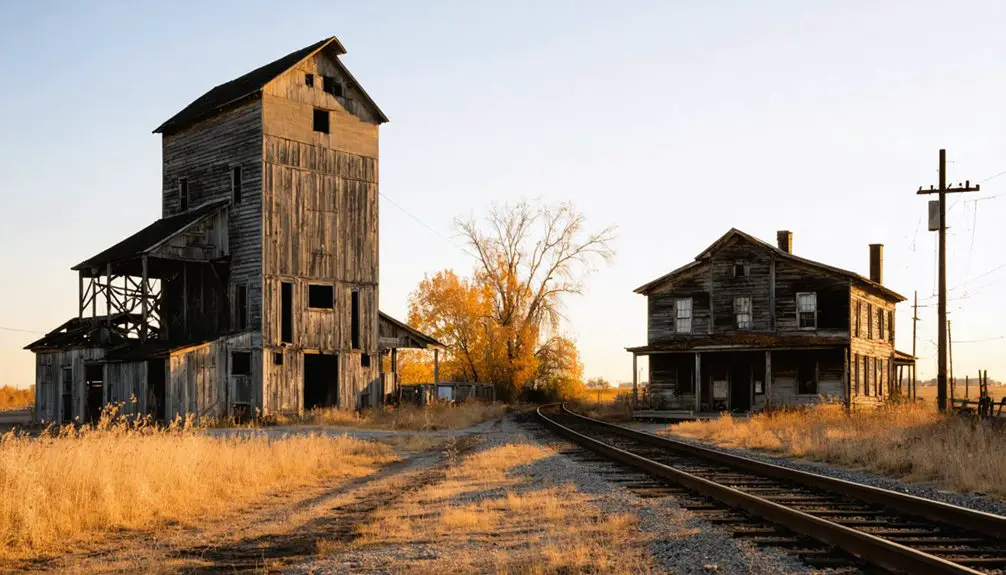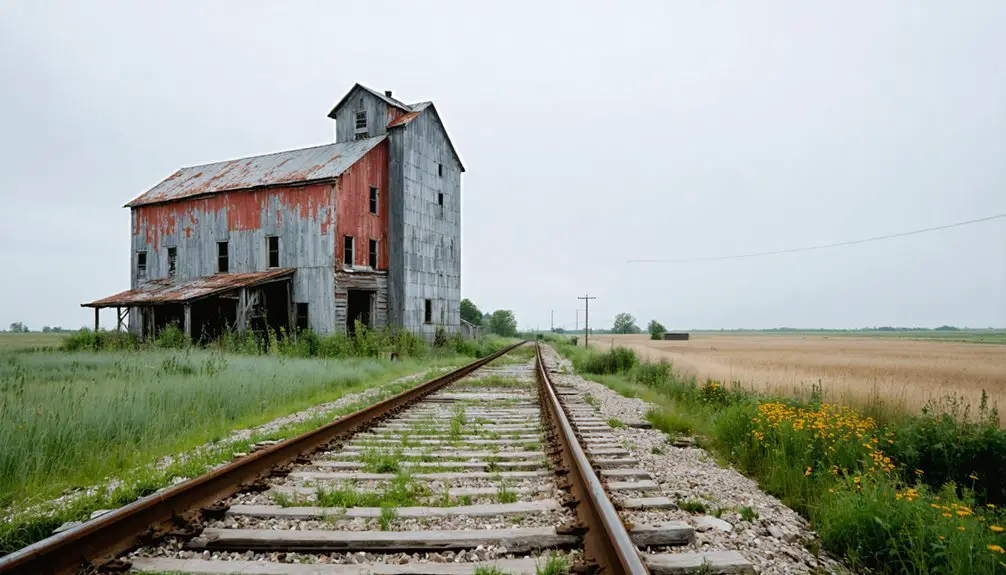You’ll find the ghost town of London tucked away in northeastern Minnesota’s boreal forests, about 75 miles northeast of Duluth near Lake Superior’s shoreline. During its peak, this frontier settlement thrived on lumber trade and featured sawmills, trading posts, and the St. Albans Inn. Today, nature has reclaimed the site, with no original structures remaining. The town’s story reveals fascinating details about early Minnesota settlement patterns and the challenges of frontier life.
Key Takeaways
- London, Minnesota is a ghost town located 75 miles northeast of Duluth near Lake Superior’s shoreline along Route 61.
- The town flourished briefly during Minnesota’s frontier expansion but declined due to limited infrastructure and the Panic of 1857.
- Economic activities centered around lumber trade and sawmills, with businesses including St. Albans Inn and various trading posts.
- No original structures remain today, with the site now consisting of open fields and wooded areas reclaimed by nature.
- Archaeological traces and foundations may exist beneath the soil, while local museums preserve artifacts from London’s past.
Location and Geographic Features
Three key geographic markers define the ghost town of London, Minnesota: its position 75 miles northeast of Duluth, its proximity to Lake Superior’s rugged shoreline, and its location along a back road from the village of Finland toward Route 61.
You’ll find this forgotten settlement at coordinates 47°12′10″N 91°34′11″W, nestled in Lake County’s wild terrain.
Its geographic significance stems from its position in Minnesota’s northeastern boreal forest, where the landscape tells stories of glacial deposits and historic logging operations. Like the prehistoric remains discovered in the Bronze Age bridge of London, England, the area contains archaeological evidence of early human settlements.
The area’s coordinates can also be expressed in the more precise decimal degrees format for modern GPS navigation.
The ecological characteristics of the area showcase a mix of dense forests, rocky outcrops, and wetlands, all influenced by Lake Superior’s moderating effect on the local climate.
Lake Superior’s mighty presence shapes the local ecosystem, creating a diverse tapestry of forests, rocks, and marshlands.
The land’s rugged nature and harsh continental climate have shaped both the settlement’s history and its eventual abandonment.
Historical Background and Settlement
You’ll find London’s origins tied closely to early trade routes that crossed northern Minnesota during the frontier expansion period.
The town emerged as settlers moved into the region, hoping to capitalize on its position near transportation corridors and natural resources typical of 19th-century Minnesota frontier towns.
The historical markers that exist today help commemorate the community’s former presence, even though no original structures remain standing.
While initial settlement brought loggers, traders, and small-scale farmers to the area, London never developed the infrastructure or economic base needed to sustain significant growth. Like many settlements that struggled during the Panic of 1857, London’s prospects for growth were severely diminished.
Early Trade Routes Impact
During the pivotal era of early Minnesota settlement, London’s location near major trade corridors shaped its initial development and economic prospects.
You’ll find that trade route dynamics in the region centered on the bustling Red River Trails, which connected Manitoba’s Red River Colony to Mississippi River ports from the 1820s to 1870s. The fur trade influence brought significant economic opportunities as traders moved goods through the area. Independent traders developed extensive commerce networks that created new opportunities for settlements like London. The American Fur Company established powerful trading monopolies throughout Minnesota by 1823, influencing the economic landscape.
- Ox carts creaking along dusty trails, laden with furs and trade goods
- Métis traders leading caravans, breaking Hudson’s Bay Company’s monopoly
- Indigenous trappers exchanging pelts for European manufactured items
- Trading posts dotting the landscape, serving as crucial commerce hubs
- Bustling activity as traders adopted Native technologies to navigate the wilderness
The trails’ proximity helped London establish itself as a small but strategic settlement before railroads changed everything.
Settlement Patterns and Growth
The rich tapestry of London’s settlement history stretches back thousands of years before European contact, with indigenous peoples making their home in this strategic location.
You’ll find that settlement dynamics were shaped by the convergence of Dakota and Ojibwe peoples at nearby Crow Wing village, which later became a hub for cultural interactions during the fur trade era.
When James McGill arrived in 1771, followed by Allan Morrison’s trading post in 1823, they tapped into existing indigenous trade networks.
The area’s population flourished through a unique blend of fur traders, Métis families, and indigenous communities.
London’s growth mirrored other Lake County settlements, with its development tied closely to transportation routes and natural resources.
The Ojibwe’s patrilineal clan system influenced the social structure of mixed families, creating a distinctive community character. Much like how the River Thames shaped London, England’s development for nearly 2,000 years, the waterways here played a crucial role in local commerce and transportation.
Regional Economic Development Era
As Minnesota emerged from the Louisiana Purchase of 1803, its economic destiny began taking shape through a complex web of fur trading, agriculture, and early industrial development.
You’ll find that economic migration transformed the region from sparse settlements to thriving trade centers, especially in the 1850s when Commissioner Eugene Burnand’s recruitment efforts drew waves of European settlers. Public investment in early childhood education emerged as a crucial factor in developing an educated workforce for the growing economy.
- Métis fur traders blazed early economic trails
- German immigrants established prosperous farming communities
- New England merchants set up bustling business districts
- Red River Valley shifted from British to American commerce
- Transportation advances opened new market opportunities
The territory’s agricultural development boomed as newcomers claimed land and built communities. The completion of Fort Snelling in 1825 established the first major American military and economic presence in the region.
You’re looking at a time when Minnesota’s abundant resources and free enterprise spirit created opportunities for folks willing to work hard and build something from scratch.
The Rise and Peak Years
Located strategically along a back road from Finland village toward Route 61 and Lake Superior, London emerged in the 19th century as European-American settlers pushed into northern Minnesota’s frontier.
Nestled on a frontier backroad near Lake Superior, London served early Minnesota settlers as a vital waypoint between destinations.
The settlement dynamics reflected the broader patterns of migration into the region, with Métis and European Americans drawn to the area’s natural resources and transit opportunities. Similar to other frontier communities where only 10% attended church, religious institutions played a minimal role in daily life.
You’d have found a growing community during London’s peak years, with wooden buildings housing general stores and community gathering spots.
The town’s position as a waypoint between Finland and Route 61 helped foster community cohesion, as residents built their lives around local industries and trade.
While never growing into a large settlement, London established itself as a modest but crucial hub for workers and families who called this corner of Lake County home.
Economic Activities and Trade

You’ll find that London’s economic life centered around its bustling lumber trade, with sawmills processing timber that workers transported across Lake Minnetonka’s waterways.
The town’s businesses included the St. Albans Inn, blacksmith shops, and trading posts that supported the logging operations and served local settlers.
While London lacked direct railroad connections, you could spot ferries and small boats moving goods between towns, though this limited transport system eventually contributed to the settlement’s decline.
Mining and Resource Operations
The discovery of rich iron ore deposits in Minnesota’s Lake Vermilion area sparked intense mining interest during the 1860s.
You’ll find that mining methods evolved from underground operations to more efficient open-pit extraction by 1900, revolutionizing how companies managed their resources. The region’s high-grade taconite ore, containing about 65% iron content, drew prospectors and mining companies enthusiastic to stake their claims.
- Massive ore deposits stretched 400-500 feet thick underground
- Open pit operations replaced traditional shaft mining
- Mining companies built entire towns to support operations
- Assayers tested for iron, manganese, and other valuable metals
- Equipment ruins and foundations still dot the landscape today
These resource management decisions shaped London’s destiny, as mining companies established the infrastructure that would later determine the town’s fate.
Trade Routes and Transportation
While mining operations shaped London’s physical landscape, extensive trade networks and transportation routes laid the groundwork for its economic connections.
You’d find the Old Red River Trail serving as an essential ox cart route through the area, while Route 61 near Lake Superior provided significant access for moving local goods. The transportation evolution from Indigenous trails to wagon roads transformed how settlers moved resources.
The region’s trade networks connected through multiple modes – you could spot steamboats maneuvering rivers seasonally, stagecoaches running between settlements, and eventually railroads changing everything.
London’s proximity to transportation nodes like Finland and Duluth helped sustain commerce through Lake Superior shipping routes. However, when railroad developments redirected trade flows, many frontier towns found themselves isolated from these new economic arteries.
Local Business Activities
Bustling with economic activity, London’s main street once housed an array of essential businesses that served both locals and travelers.
You’d find the typical establishments of a thriving Minnesota settlement, where local markets flourished through various trades and services.
- A general store stocked with daily necessities and farming supplies
- A post office that doubled as a community gathering spot
- Blacksmith shops maintaining crucial equipment for farmers
- Hotels and saloons catering to railroad workers and travelers
- Small bakeries and butcher shops serving the community
Like many Minnesota ghost towns, London’s business decline followed familiar patterns.
When economic troubles struck, particularly during the Panic of 1857, businesses struggled to maintain profitability.
The town’s entrepreneurs, facing dwindling resources and changing trade routes, eventually had to shut their doors or relocate.
Transportation Routes and Access

Located along Minnesota’s early transport arteries, London initially benefited from the region’s extensive waterway network that served as vital trade routes before railroads arrived.
You’d find steamboats regularly stopping by, connecting the town to other settlements along the water routes, especially after the 1851 Indian treaties opened up more navigation opportunities.
But when the railroads pushed north in 1871, they bypassed London completely.
You couldn’t catch a train there – it was stuck on an old back road linking Finland to Route 61 and Lake Superior.
While other towns thrived with rail connections, London had to rely on crude wagon trails and seasonal water transport.
Without direct access to the faster, year-round railroad service, the town’s isolation grew, and folks gradually moved to better-connected communities.
Factors Leading to Abandonment
Several key factors sealed London’s fate as a ghost town, working together like dominoes falling one after another.
Poor resource management of the area’s natural wealth, combined with weakening community cohesion, created a perfect storm that you can still see evidence of today.
The town’s decline accelerated as residents faced mounting challenges:
- Young folks left for bigger cities, leaving aging populations behind
- Natural resources that once sustained the economy dried up
- Old transportation routes became obsolete as railroads bypassed the town
- Key businesses and services shut down one by one
- Harsh environmental conditions and isolation took their toll
Without fresh investment or new opportunities, London couldn’t adapt to changing times.
The community’s foundation crumbled as each challenge chipped away at the town’s viability.
Present-Day Remnants and Site Conditions

Despite its rich history as a frontier settlement, today’s London site reveals little of its former self to passing visitors.
Once a bustling frontier outpost, London now whispers its stories only through empty fields and forgotten foundations.
You’ll find mostly open fields and wooded areas where the town once stood, with current site conditions showing nature’s steady reclamation of the land. Unlike preserved ghost towns such as Forestville, London doesn’t maintain any original buildings on-site.
If you’re planning to explore, you’ll need to navigate unmarked access points and possibly seek permission from private landowners, as much of the area has been converted to agricultural land.
The only physical remnants you might discover are scattered foundations and archaeological traces hidden beneath the soil.
While local museums house artifacts and photographs from London’s past, the ghost town itself stands as a quiet memorial to the changing fortunes of frontier Minnesota.
Exploring the Ghost Town Today
Today’s adventurers seeking London’s ghostly remains will find themselves traversing through northeastern Minnesota’s dense forests, about 75 miles northeast of Duluth.
You’ll need a high-clearance vehicle or sturdy hiking boots to access this remote ghost town exploration site at 47°12′10″N 91°34′11″W.
- Decaying foundations peek through thick forest undergrowth
- Early morning fog drifts between trees, creating perfect natural photography conditions
- Wildlife rustles in the surrounding wilderness, adding life to the abandoned scene
- Fall colors and winter snow transform the ruins into seasonal photo opportunities
- Old back roads wind through history, connecting Finland village to Lake Superior
Pack emergency supplies and notify others of your plans – there’s no cell service here.
You’ll want water, food, and proper gear while exploring these untamed ruins where nature’s slowly reclaiming her territory.
Legacy in Minnesota’s History

While many Minnesota ghost towns have faded into obscurity, London’s legacy endures as a tribute to the state’s pioneering spirit and economic evolution.
You’ll find its story woven into the fabric of Lake County’s history, showcasing the cultural resilience of early settlers who established communities along essential trade routes near Lake Superior.
London’s tale mirrors the pioneer challenges faced by countless frontier towns across Minnesota.
Though its stores, post office, and local industries are long gone, you’re witnessing a snapshot of rural development that shaped the state’s character.
As part of Minnesota’s ghost town network, London helps map the ebb and flow of settlement patterns, reminding you how transportation shifts and changing economic forces molded the landscape you see today.
Frequently Asked Questions
Are There Any Known Burial Sites or Cemeteries Near London?
You’ll find Loon Lake Cemetery as the closest documented burial grounds to London’s site, though it’s a fair distance south near Lakefield. Local cemetery history suggests other unmarked plots might exist.
What Was the Peak Population of London During Its Active Years?
Like a fading whisper in time, you won’t find London’s exact peak population documented. Historical significance suggests it’d be smaller than other ghost towns, likely below 150 residents during its heyday.
Were There Any Schools or Churches Established in London?
You won’t find any records of schools or churches in London. Historical searches show no school history or church significance there – folks likely traveled to nearby towns for their learning and worship.
Did Any Notable Minnesota Historical Figures Live in London?
Like a blank page in Minnesota’s history book, London didn’t host any notable historical figures. You won’t find records of significant residents who called this small, remote settlement home before it faded away.
What Types of Buildings or Businesses Originally Existed in London?
You’d find historic architecture like the J.K. Wells Hotel, saloons, general stores, and a creamery. Local industries were supported by cabins, outhouses, doctors’ offices, and two-story homes with fancy gardens.
References
- https://kids.kiddle.co/London
- https://www.startribune.com/ghost-towns-minnesota-nininger-forestville-old-crow-wing/601169483
- https://kool1017.com/this-haunted-minnesota-road-might-give-you-nightmares/
- https://en.wikipedia.org/wiki/London
- https://www.albertleatribune.com/2012/04/progress-ghost-towns-of-freeborn-county/
- https://latitude.to/articles-by-country/us/united-states/194499/rice-lake-ghost-town-minnesota
- https://www.coordinatesfinder.com/coordinates/1934493-new-london-mn
- https://latitude.to/articles-by-country/us/united-states/167652/radium-minnesota
- https://www.frrandp.com/p/ghost-towns-map.html
- https://www.minnesotahistory.org/post/a-complete-guide-to-the-ghost-towns-of-hennepin-county



